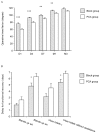Antiinflammatory effect of peripheral nerve blocks after knee surgery: clinical and biologic evaluation
- PMID: 18719447
- PMCID: PMC2758602
- DOI: 10.1097/ALN.0b013e318182c2a1
Antiinflammatory effect of peripheral nerve blocks after knee surgery: clinical and biologic evaluation
Abstract
Background: Nerve blocks provide analgesia after surgery. The authors tested whether nerve blocks have antiinflammatory effects.
Methods: Patients had combined sciatic (single-shot) and continuous femoral block (48 h) (block group) or morphine patient-controlled analgesia after total knee arthroplasty. Pain at rest and upon movement was monitored at 1 (D1), 4 (D4), and 7 days (D7) and 1 (M1) and 3 months (M3) after surgery. Knee inflammation was evaluated (skin temperature, knee circumference) before surgery and at D1, D4, D7, M1, and M3. Plasma cytokine concentrations (interleukin [IL]-6, IL-1beta, tumor necrosis factor [TNF], IL-10, soluble receptor 1 of TNF [sTNF-R1]) were measured before surgery and at 4 h, D1, D4, and D7 after surgery. Capsule and synovial membrane cytokines were measured (IL-6, TNF, IL-1, IL-10). Knee flexion was evaluated before surgery and at D1, D4, D7, M1, and M3. Morphine use and recovery time to autonomy were monitored.
Results: Pain at rest and upon movement was lower in the block group than in patient-controlled analgesia patients between D1 and D7 (analysis of variance, P < 0.005). Knee flexion was improved in the block group for D1 to M1 (analysis of variance, P < 0.0001). Block group patients recovered nonassisted mobilization (t test, P = 0.04) and toilet use (t test, P = 0.03) more rapidly. Knee circumference and skin temperature were lower in the block group between D1 and D7 (analysis of variance, P < 0.05). Synovial membrane IL-1 (P < 0.05) and IL-10 (P < 0.01) increased, and plasma IL-6 and sTNF-R1 peaked at 24 h, with no difference between groups.
Conclusion: Nerve blocks inhibited clinical inflammation after total knee arthroplasty, with no change in tissue and plasma cytokine concentrations.
Figures





Comment in
-
Antiinflammatory effect of peripheral nerve blockade.Anesthesiology. 2009 May;110(5):1189; author reply 1189. doi: 10.1097/ALN.0b013e31819faa89. Anesthesiology. 2009. PMID: 19387185 No abstract available.
References
-
- Richman JM, Liu SS, Courpas G, Wong R, Rowlingson AJ, McGready J, Cohen SR, Wu CL. Does continuous peripheral nerve block provide superior pain control to opioids? A meta-analysis. Anesth Analg. 2006;102:248–57. - PubMed
-
- Block BM, Liu SS, Rowlingson AJ, Cowan AR, Cowan JA, Jr, Wu CL. Efficacy of postoperative epidural analgesia: a meta-analysis. Jama. 2003;290:2455–63. - PubMed
-
- Singelyn FJ, Deyaert M, Joris D, Pendeville E, Gouverneur JM. Effects of intravenous patient-controlled analgesia with morphine, continuous epidural analgesia, and continuous three-in-one block on postoperative pain and knee rehabilitation after unilateral total knee arthroplasty. Anesth Analg. 1998;87:88–92. - PubMed
-
- Capdevila X, Barthelet Y, Biboulet P, Ryckwaert Y, Rubenovitch J, d’Athis F. Effects of perioperative analgesic technique on the surgical outcome and duration of rehabilitation after major knee surgery. Anesthesiology. 1999;91:8–15. - PubMed
-
- Le Bars D, Adam F. Nociceptors and mediators in acute inflammatory pain. Ann Fr Anesth Reanim. 2002;21:315–35. - PubMed

